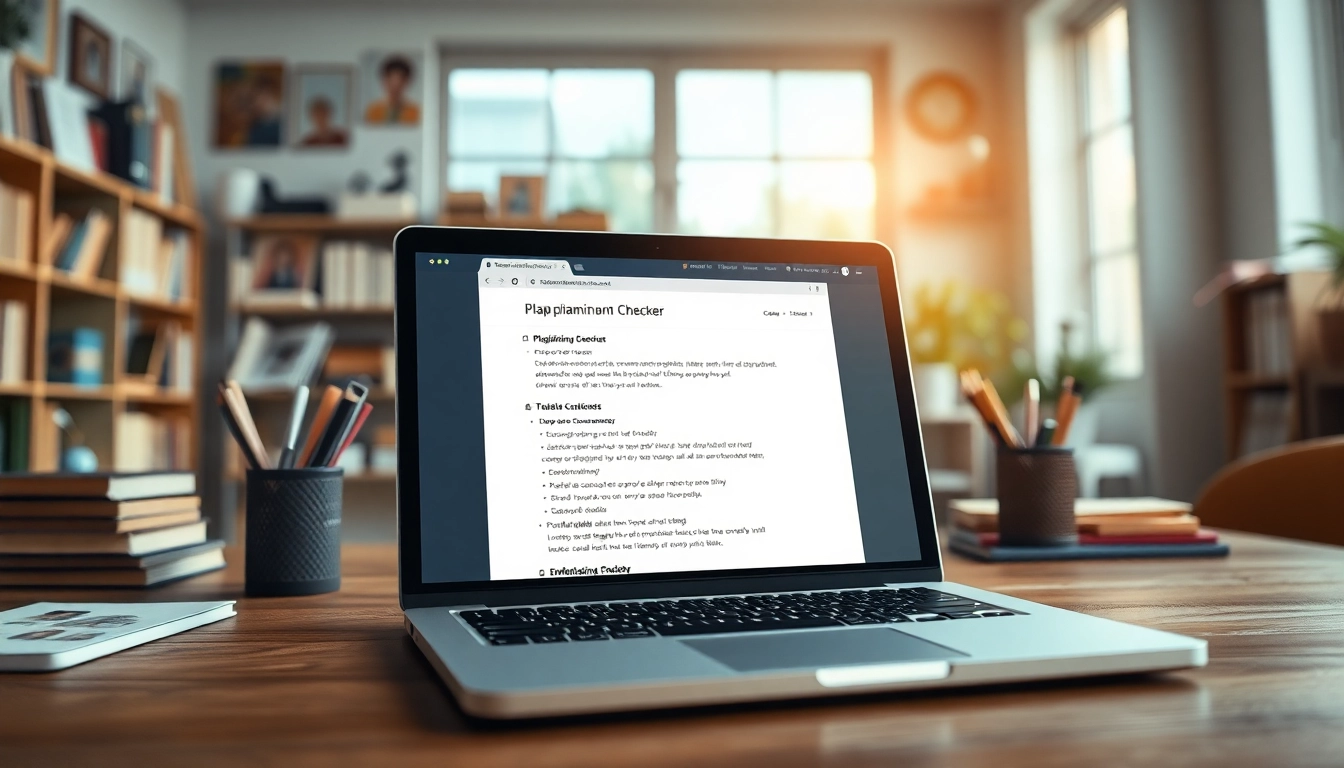Understanding Plagiarism and Its Consequences
In an era where information is easily accessible, the risk of unintentional plagiarism has grown substantially. Understanding plagiarism and its ramifications is critical for students, educators, and professionals alike. This awareness not only fosters academic integrity but also encourages originality in content creation. Utilizing a reliable plagiarism checker is crucial in this process, ensuring all work produced is unique and credible.
What Constitutes Plagiarism?
Plagiarism is defined as the act of using someone else’s work, ideas, or expressions without giving proper credit. This includes a range of actions, from copying text verbatim to paraphrasing without citation. Plagiarism can be intentional or unintentional and typically falls into several categories:
- Direct Plagiarism: Copying text word-for-word without attribution.
- Self-Plagiarism: Reusing one’s prior work and presenting it as new.
- Patchwork Plagiarism: Piecing together information from various sources to create a new document without proper citation.
- Accidental Plagiarism: Failing to cite sources or misattributing authorship, often due to lack of knowledge about citation conventions.
Consequences of Plagiarism in Academia
The consequences of committing plagiarism can be severe, particularly in educational institutions. Potential repercussions include:
- Disciplinary Actions: Many educational institutions have strict policies regarding plagiarism that can result in penalties ranging from a failing grade to expulsion.
- Loss of Credibility: A record of plagiarism can damage a student’s or professional’s reputation, impacting future academic and career opportunities.
- Legal Consequences: Plagiarism can lead to legal action, particularly in cases involving copyrighted material.
Legal Implications of Plagiarism
In addition to academic consequences, plagiarism can have legal ramifications. Laws surrounding copyright infringement can lead to lawsuits if original creators decide to pursue legal action. Understanding copyright ownership and the rights of authors in various contexts can help mitigate the risks associated with plagiarism.
How a Plagiarism Checker Works
Utilizing a plagiarism checker is an effective way to ensure that written work adheres to academic and professional integrity standards. These tools scan documents against vast databases, determining the originality of the content. Understanding how these checkers work can help users maximize their effectiveness.
Technology Behind Plagiarism Checkers
Plagiarism checkers operate through sophisticated algorithms and databases. The primary technology involves:
- Text Matching: These tools compare submitted text with existing content on the internet and within proprietary databases to identify similarities.
- Machine Learning: Many modern plagiarism checkers employ machine learning techniques to improve pattern recognition and enhance accuracy over time.
- Natural Language Processing: This enables the software to understand context, which helps to differentiate between common phrases and genuine instances of plagiarism.
Types of Content Analyzed
Plagiarism checkers can analyze various types of content, including:
- Academic Papers: Essays, dissertations, and theses are commonly analyzed in educational settings.
- Web Content: Blogs and articles posted online are also scrutinized for originality.
- Books and Publications: Plagiarism checkers can evaluate manuscript submissions to publishers ensuring authenticity.
Accuracy and Reliability Metrics
The accuracy of a plagiarism checker is paramount for delivering reliable results. Key metrics include:
- Percentage of Similarity: The overall percentage indicating how much of the document matches existing sources.
- Source Database Size: The breadth of the database influences the comprehensiveness of results.
- Update Frequency: Regular updates to databases ensure that new content is included, improving detection capabilities.
Choosing the Right Plagiarism Checker
With the plethora of plagiarism checkers available, selecting the right one for specific needs is essential. Various features differentiate these tools and influence their effectiveness.
Features to Look For
When selecting a plagiarism checker, consider the following features:
- Real-time Check: Some tools provide instant results, allowing for immediate feedback during the writing process.
- User Interface: A simple, intuitive interface can enhance the user experience.
- Support for Multiple Formats: The ability to analyze various document types (e.g., PDFs, DOCX, TXT) adds flexibility.
- Detailed Reports: Comprehensive summaries that highlight matched sources are essential for quality evaluation.
Popular Tools and Their Distinct Benefits
While many tools are available, they often cater to different audiences and use-cases. Understanding their unique benefits can assist in making an informed choice:
- Institution-Based Checkers: These are often utilized by universities and provide enhanced accuracy for academic papers.
- Online Free Tools: Many basic plagiarism checkers are available online, which can suffice for casual use or small projects.
- Comprehensive Checkers: Paid versions generally offer expanded databases, more in-depth analysis, and additional writing tools, making them ideal for professionals.
Free vs. Paid Plagiarism Checkers
The debate between free and paid plagiarism checkers centers on value and depth:
- Free Checkers: While convenient, they often have limitations in terms of database size and accuracy, making them suitable for informal use.
- Paid Options: These can offer greater precision, advanced features, and robust customer support, essential for academia, publishing, and professional environments.
Best Practices for Using a Plagiarism Checker
Maximizing the benefits of a plagiarism checker involves following best practices. It’s not just about running your text through the tool; it’s also about understanding and acting on the results.
Preparing Your Work for Analysis
Prior to using a plagiarism checker, ensure that your work is in a suitable format. Formatting issues can sometimes lead to inaccuracies in checking, so it’s best to:
- Use standard file formats (e.g., DOCX, PDF).
- Check for formatting errors, as complex formatting can confuse some checkers.
- Ensure the text is clear and organized to help yield better results.
Interpreting the Results
Once you receive your plagiarism report, interpreting the results is critical. Key areas to focus on include:
- Highlighted Matches: Review the sections marked as matching; these need your attention.
- Source Listings: Understand where the matching content originates to correctly attribute or rewrite.
- Percentage Scores: Evaluate the percentage of similarity and prioritize addressing significant overlaps.
Revising Based on Feedback
Revising your work based on the feedback from the plagiarism checker is vital. Recommended steps include:
- Rewriting Sections: For content that closely matches existing sources, consider rewriting those sections to add originality.
- Adding Citations: Wherever applicable, ensure you cite sources correctly to attribute original authorship.
- Using Paraphrasing Tools: These can assist in rewording sections that need refinement while maintaining the original meaning.
Future Trends in Plagiarism Detection
The landscape of plagiarism detection is continually evolving with advancements in technology and educational practices. Looking ahead, several trends are emerging.
AI and Machine Learning Innovations
Future plagiarism checkers will increasingly incorporate AI and machine learning, enhancing their ability to detect nuanced forms of copying and improper citation. This development could lead to:
- Greater Contextual Understanding: Tools will analyze not just the text but also the intent behind users’ modifications to differentiate genuine creativity from plagiarism.
- Improved Detection of Paraphrasing: Enhanced algorithms may identify paraphrased content more effectively, ensuring more comprehensive evaluation.
Potential Developments in Academic Integrity
As educational institutions aim to uphold academic integrity, new policies fostering originality will be implemented. These could include:
- Mandatory Use of Plagiarism Tools: Institutions may begin requiring students to use plagiarism checkers prior to submission for evaluation, thus normalizing integrity practices.
- Enhancements in Education: Workshops and courses around proper citation practices may become more prevalent, instilling correct habits in students early on.
Embracing Originality in Content Creation
Encouraging originality will become a focal point in both academic and professional settings. As more organizations value unique content, strategies for fostering creativity must also evolve:
- Incorporating Collaborative Work: Group projects can stimulate diverse thinking, leading to innovative outcomes.
- Utilizing Writing Centers: Institutions can create writing resources to help individuals hone their skills in producing unique work.
- Highlighting Success Stories: Sharing examples of successful projects that emphasize originality can inspire others to pursue their creative paths.



